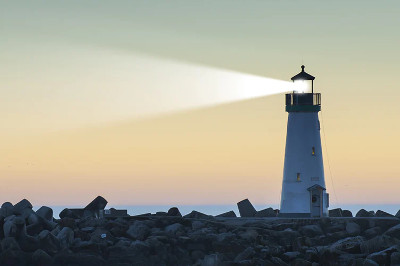Od ochrony statków po unikanie martwych punktów: modelowanie i używanie soczewki Fresnela.
From protecting ships to avoiding blind spots: modeling and using the Fresnel lens
In the BBC article, “The invention that saved a million ships,” the author chronicles how and why physicist Augustin Fresnel in the 1820s invented what would become one of the most well-known and practical lenses today. Fresnel lenses are used for all sorts of practical applications in industries from solar energy to automotive to entertainment and likely go beyond Augustin Fresnel’s wildest dreams. No matter the application, optical engineers working on Fresnel lenses will find the right model in OpticStudio.
Illuminating the way for ships
According to the BBC, “Lamp power was no match for a dark and stormy night; over centuries, broken hulls and wind-whipped sails ran aground as ships’ captains and crew perished within, unable to spot the coastline before it was too late. All that changed in the early 1820s, when a French physicist invented a new kind of lens: a ring of crystalline prisms arranged in a faceted dome that could reflect refracted light. Augustin Fresnel installed his creation in the Phare de Cordouan, a towering lighthouse situated in France’s Gironde estuary, about 100km north of Bordeaux. Suddenly, one lamp could illuminate the way for sailors many nautical miles out to sea.”
From reverse lights to comic effect, modern uses of the Fresnel lens
Fresnel lenses can be made much thinner than a traditional lens, and in some cases, even as thin as a flat sheet, making them ideal for many uses. Still a staple in lighthouses, Fresnel lenses are also used as handheld magnifiers, to correct visual disorders or blind spots, in traffic lights, in car tail and reverse lights, on rear-view mirrors, to reduce the size of telephoto lenses, in aircraft optical landing systems, in projectors, to concentrate sunlight for solar power—and even in entertainment. According to Wikipedia, “The British rock artist Peter Gabriel made use of them in his early solo live performances to magnify the size of his head, in contrast to the rest of his body, for dramatic and comic effect.”
From an optical design standpoint, a Fresnel lens is a concave or convex lens that has been clasped in the z-direction. The profile is discontinuous and has grooves that minimize its thickness, but it is otherwise identical to a curved surface. Because the Fresnel lens is thin, there’s minimal light loss due to absorption at the expense of image quality.
Fresnel models available in OpticStudio
There are several Fresnel lens models available in sequential and non-sequential modes in OpticStudio.
Sequential mode
Note that all models are ideal, which means that the software idealizes the grooves to be of infinitesimal height. OpticStudio traces rays to the surface, ignoring the presence of the grooves, and then refracts rays as though the grooves truly exist. The substrate of a Fresnel surface can be flat or curved.
Fresnel: The Fresnel surface is modeled as a flat surface. Once the ray has intercepted the plane surface, the ray reflects or refracts as if the surface had a shape described by an even asphere.
Generalized Fresnel: The Generalized Fresnel surface uses a polynomial aspheric substrate model, identical to the Even Aspheric surface. After the ray has intercepted the surface, the ray reflects or refracts as if the surface had a shape described by an extended polynomial.
Extended Fresnel: In the Extended Fresnel surface, the surface sag is identical to the Even Asphere surface and the sag is used for the ray-surface intercept. The refraction or reflection of the surface is determined by the local slope of the Fresnel facets, which is impacted by the Fresnel facet shape expression for Zf and the substrate shape expression for Zs. The refraction at the surface accounts for both the substrate sag and the Fresnel sag, while the ray-surface intercept depends only on the substrate sag.
Cylinder Fresnel: In the Cylinder Fresnel surface, the surface sag is identical to the Even cylindrical Asphere surface (in y) and it is used for the ray-surface intercept. The refraction or reflection of the surface is determined by an another even cylindrical asphere sag equation. The refraction at the surface accounts for the Fresnel sag, while the ray-surface intercept depends on the substrate sag.
Non-sequential mode
Models in non-sequential mode can be ideal or real. Ideal models are based on the same approximation as the sequential case (the grooves are of infinitesimal height). Real models define the exact profile shape.
Fresnel 1: In the Fresnel 1 surface, the profile is made of radially flat faces. The endpoints of the faces follow the equation of the Even Asphere surface.
Fresnel 2: The Fresnel 2 is an idealized Fresnel lens. This object works as the sequential Fresnel surface.
Tabulated Fresnel Radial: The Tabulated Fresnel Radial is a tabulated object based on YZ sag coordinates defined in a TOB file. A TOB file contains two columns of data: the first column represents the local Y coordinate, and the second column represents the local Z coordinate. A figure of revolution around the local Z axis is generated by replicating the YZ curve over a specific angular range. The radially symmetric faces that result are smooth.
Tabulated Faceted Radial: The Tabulated Faceted Radial object is nearly identical to the Tabulated Fresnel Radial object. The key difference is that the radially symmetric faces are not smooth in this object, as opposed to the Tabulated Fresnel Radial described above.
Other Fresnel lenses: When working in non-sequential mode, there are several solutions to resolve instances when any of the built-in objects are not appropriate to describe a Fresnel lens. For example, a Fresnel lens can be built from a series of annular aspheric lenses.
Whatever the application, using OpticStudio to model Fresnel lenses is a straightforward way to get your designs to market faster.

